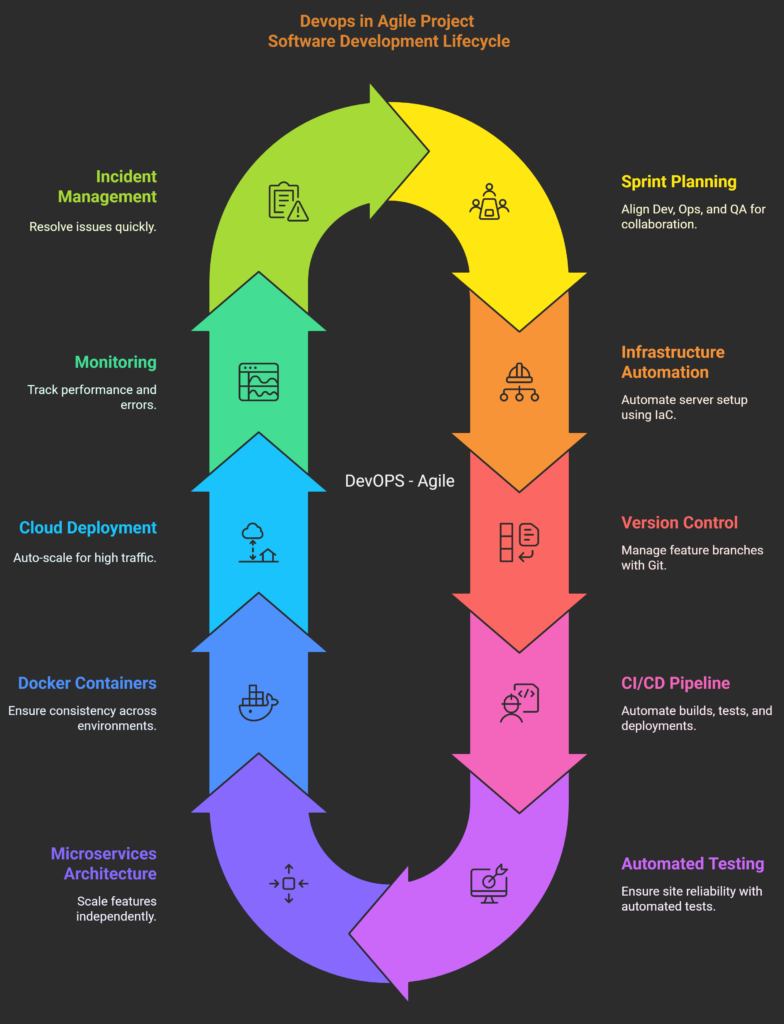
Customers expect constant updates, but pushing code fast often leads to bugs, crashes, and midnight firefighting. That’s why top teams are combining Agile’s project management with DevOps’ automation power.
Let’s say you’re building an e-commerce website that allows users to browse products, add items to the cart, and make payments. Here’s how DevOps Agile integration transforms every phase:
1. Continuous Planning & Collaboration
✔️ Agile Approach: The team holds sprint planning meetings to define user stories (e.g., “Users should be able to search for products”).
✔️ DevOps Agile Fit: Developers, testers, and operations work together from day one, ensuring infrastructure and deployment needs are considered early.
2. Infrastructure as Code (IaC) for Fast Setup
✔️ Example: Instead of manually setting up servers for the e-commerce platform, DevOps uses Terraform or AWS CloudFormation to create them automatically.
✔️ DevOps Agile Fit: Faster, repeatable, and consistent environment setup across Dev, QA, and Production.
3. Version Control for Collaboration
✔️ Example: Developers work on different features (e.g., “Add to Cart” & “Checkout”) in separate Git branches.
✔️ DevOps Agile Benefit: Code is managed in GitHub/GitLab/Bitbucket, ensuring no conflicts and smooth merging.
4. Continuous Integration (CI) for Faster Testing
✔️ Example: When a developer commits code for a new “Product Recommendation” feature, Jenkins/GitHub Actions runs automated tests.
✔️ DevOps Agile Benefit: Bugs are caught early, and code quality is maintained.
5. Automated Testing for Reliability
✔️ Example: Selenium is used to automate UI tests for the “Add to Cart” feature across different devices.
✔️ DevOps Agile Benefit: Prevents manual errors and speeds up releases.
6. Continuous Deployment (CD) for Faster Releases
✔️ Example: When all tests pass, the new “Flash Sale” feature is automatically deployed to a staging server using Kubernetes & Helm.
✔️ DevOps Agile Benefit: Saves time and avoids manual deployment mistakes.
7. Microservices for Scalable Features
✔️ Example: The Product Search, Cart, and Payment Gateway are built as separate microservices, making it easy to scale and update independently.
✔️ DevOps Agile Benefit: The checkout system can handle more traffic on Black Friday without affecting product browsing.
8. Containerization for Portability
✔️ Example: The e-commerce website runs inside Docker containers, ensuring it works the same on developer laptops, testing environments, and production servers.
9. Cloud Deployment for Flexibility
✔️ Example: The site is hosted on AWS/GCP/Azure, using auto-scaling to handle high traffic during sales events.
✔️ Benefit: The system scales automatically, preventing crashes.
10. Monitoring for Performance Insights
✔️ Example: Prometheus & Grafana monitor server response times and database performance.
✔️ DevOps Agile Benefit: If checkout takes too long, alerts notify the DevOps team to investigate.

11. Incident Management for Quick Fixes
✔️ Example: If payment transactions start failing, PagerDuty or Slack alerts notify the team immediately.
✔️ Benefit: Faster resolution, less downtime.
12. Security Integration (DevSecOps)
✔️ Example: Automated security scans (e.g., SonarQube) check for vulnerabilities in the payment processing code.
✔️ Benefit: Ensures customer data is protected from cyber threats.
13. Feature Flags for Safe Rollouts
✔️ Example: A new “One-Click Checkout” feature is gradually rolled out to 10% of users before full deployment.
✔️ Benefit: Reduces the risk of breaking the entire checkout system.
14. A/B Testing for Customer Experience
✔️ Example: Two versions of the homepage are tested (A = Simple Layout, B = Complex Layout) to see which one increases sales.
✔️ Benefit: Data-driven decision-making for UI improvements.
15. Rollback Mechanism for Stability
✔️ Example: If a new “Wishlist” feature causes checkout failures, GitHub Actions can rollback to the previous stable version.
✔️ Benefit: Avoids prolonged downtime and customer frustration.
16. Blue-Green Deployments for Zero Downtime
✔️ Example: Version 1 runs in Blue environment; Version 2 is tested in Green. After validation, traffic is switched to Green.
✔️ Benefit: Users don’t experience downtime when new features are deployed.
17. Performance Testing to Handle High Traffic
✔️ Example: Load testing (JMeter) simulates 10,000 users purchasing at once to ensure the site doesn’t crash.
✔️ Benefit: Prevents failures during Black Friday or flash sales.
18. Backups & Disaster Recovery Plan
✔️ Example: Daily database backups are stored securely in AWS S3.
✔️ Benefit: If data is lost, it can be restored quickly.
19. Agile Retrospectives with DevOps Metrics
✔️ Example: Sprint reviews analyze deployment frequency, failed releases, and bug resolution time to improve future sprints.
✔️ Benefit: Continuous improvement with data-driven feedback.
20. Customer Feedback Loop for Fast Updates
✔️ Example: Users report issues with the new “Coupons” feature, and fixes are pushed within hours using the CI/CD pipeline.
✔️ Benefit: Faster response to customer needs, improving satisfaction.
Final Thought
In software, speed and stability aren’t opposites—they’re partners. The right combination of Agile flexibility and DevOps automation makes both possible. Now it’s your turn to find that balance for your team.
Since you made it this far without dozing off, here’s a pop quiz: We ‘accidentally’ forgot to mention why containerization is like a suitcase for your apps. Instead, you tell us what could be the benefit! (we’ll know if you Google it).
Want to kickstart your IT career? Here are the top 10 IT entry-level jobs you need to know about!



